A Digital Model-Based Serious Game for PID-Controller Education: One-Axis Drone Model, Analytics, and Student Study
Abstract
1. Introduction
- whether collected error values are useful for diagnosing students’ issues with tuning;
- whether brief, unsupervised use of the serious game leads to measurable gains in student knowledge;
- whether a second attempt reduces tuning effort without degrading tune quality.
2. Related Work
- Serious Games in Education;
- Digital Twins in Education and Industry;
- Automation and Control in Industry 4.0/5.0.
2.1. Serious Games in Education
2.2. Digital Twin in Education and Industry
2.3. Automation and Control in Industry 4.0 and 5.0
3. Proposed Solution
3.1. Choosing a Physical Twin
3.2. Core Functionality
3.3. Implementation
3.3.1. Technologies Used
3.3.2. Scene Setup
3.3.3. Physics Simulation
3.3.4. One-Axis Drone Digital Model Implementation
- 1.
- PID Controller: The PID-controller logic is situated in the script called PIDController. The PID controller, in its continuous form, is expressed as:where e(t) is the error between the target and the current angle, and KP, KI, and KD are the proportional, integral, and derivative gains. The error is calculated by subtracting the current value from the target value. However, since the simulation runs in discrete time, the equation looks like this:To ensure stability in cases when the error persists for long periods of time, the implementation includes an anti-windup mechanism, which clamps the integral term between a minimum and maximum value. Furthermore, the final output of the PID controller is clamped between configurable limits in order to prevent unrealistic values.Normally, for the derivative term, the change in error is calculated and used. However, when the target angle suffers a sudden change, this implementation can cause the derivative term to reach very high values for one frame, resulting in a derivative kick. To mitigate this effect, the derivative term was instead computed from the measured rate of change in the roll angle. By calculating the rate of change from the process variable, we ensure that the derivative term responds only to changes in the system state, and not to jumps in the target value.
- 2.
- Motor force application and visual feedback: The script called OneAxisDroneByMotorForce has the purpose of taking the output of the PIDController script and actuating the motors. At each physics step (FixedUpdate in Unity), it computes the required thrust for each motor by scaling the normalized controller output with a maximum thrust constant and clamping the values to ones accurate to a generic 2205 brushless motor. A minimum thrust is maintained as normal brushless motors of drones always keep a minimum RPM. The computed thrusts are applied at the motor position, taking into account the motor orientation, based on the current drone orientation. This application of thrust at motor positions generates the required torque for controlling the rotation on the roll axis while the ConfigurableJoint component constrains all degrees of freedom except for the roll axis.Since this script already reads the output of the PIDController and computes the forces applied to motors, it made sense to extend it to also compute the motors’ rotational speed. The maximum speed is determined from parameters of real-life motors (KV value) and the battery powering them (battery cell count), while the instantaneous speed is set proportionally to the determined thrust. The speed values are passed to the MotorRotationScript, ensuring consistency between the visual representation and simulated physics. Even though the motors and propellers are not required for the drone to function correctly, they are integral to strengthening the student’s perception of motor activity and its effect on the whole system, making the serious game more pedagogically effective.
- 3.
- Target angle control: TargetMoverMotorForce is the script that sets the value that the PID controller uses as the target. It allows the developer (and the player, through the UI) to set it manually to a fixed value or to set rules for it to oscillate between two values, with the desired speed. The script increases the flexibility of the serious game by enabling demonstrations of both static and dynamic targets.
- 4.
- Simulation flow: The scripts described above make up the digital model that sits at the forefront of the serious game, linking user control logic and physics-based response with user interaction. Each script is responsible for a specific function, such as computing control actions, applying forces, animating visual elements, or introducing disturbances, and together they form and control a coherent digital model that allows students to experience how parameter tuning affects system behavior.Figure 5 shows the flow of information and actions between elements of the simulation. The player defines a static or dynamic target (or leaves it at the default value of zero), which is then compared by the drone’s current roll angle, obtained from the Rigidbody component. Their difference constitutes the error, which is further used by the PID controller to compute the control output. The resulting value is read by OneAxisDroneByMotorForce, which translates it into differential thrust values for the two motors. Forces with these magnitudes are applied as if they originated from the motors themselves, generating the torque that rotates the drone on the roll axis. During the next frame, the cycle is repeated.External disturbances interact with the system through the physics simulation, and they influence the Rigidbody’s state, thus eliciting a response from the PID controller, which will try to maintain their desired roll angle. This ensures players receive immediate, visually observable feedback to their tuning efforts.
- 5.
- Adjustable parameters: As described in this chapter, a modular approach was used when building the drone simulation, with each component containing several parameters that can be modified, some by the developer, inside Unity, and other by the programmer, inside the UI. Table 1 summarizes the main adjustable parameters and their functions, along with whether they are available only for developers or also for players.
3.3.5. External Disturbance Simulation
3.3.6. User Interface
4. Results
4.1. Testing Methodology
4.1.1. Goal and Research Questions
- RQ1: Do error values provide actionable diagnostic signals that can help instructors identify PID tuning issues that students are having?
- RQ2: Does a short, unsupervised tinkering session improve quiz scores and stability-oriented metrics?
- RQ3: Does tinkering effort decrease from the first tinkering session to the second one without degrading stability-oriented performance?
4.1.2. Participants and Context
4.1.3. Study Design
4.1.4. Tools
4.1.5. Procedure
- Step 1: Background quiz
- Step 2: 30-min theory/practical course
- Step 3: App introduction and controller functioning quiz
- Step 4: First tinkering phase
- error value in degrees for the entire session
- last error value of the sessions
- total session duration in seconds, up to a maximum of 600 s, as the game stopped at that time
- number of parameter changes performed during the session
- Step 5: Post-tinkering quiz
- Step 6: Second tinkering phase
- Step 7: Final quiz
4.1.6. Collected and Derived Metrics
- Quiz 1 (background information): age, country of origin, country of study, technical background, and prior exposure to PID controllers.
- Quiz 2 (knowledge application on the digital model’s PID controller): purpose of the PID controller, error computation, and how the PID controller is used by the system.
- Quiz 3 (post tinkering knowledge application on the digital model’s PID controller): same format as Quiz 2, enabling direct pre–post comparison.
- Quiz 4 (final quiz): self-assessment of the perceived improvement in understanding PID controllers, plus open-ended feedback on improving the serious game.
- Submission time: sent at the end of the tinkering session. Contains the date and time of the end of the current tinkering session.
- Play time: sent at the end of the tinkering session. Contains the time that the player spent in-game, in seconds.
- Number of parameter changes: tracked throughout the tinkering session and sent at the end. Contains the number of times the player applied a change to the values used by the PID controller.
- Error values: tracked throughout the tinkering session and sent at the end. Contains the value of the roll angle, sampled at 10 Hz for the entire tinkering session. Stored as a list of values in degrees.
- Final error: sent at the end of the tinkering session. Contains the last recorded error value in degrees.
- Stability threshold: the tinkering phase instructions stated that an error of less than 0.4° was set as the goal to be reached by the students and was considered good enough for the purpose of this study. For this, the minimum and maximum values present in the earliest 10 s section with the lowest error value were calculated, along with the mean error value on that segment and its starting point in time.
- Normalized area under absolute error: this metric was devised to provide a session-wide stability summary for easy comparison between sessions. It was calculated by taking the absolute value of all collected error values, followed by calculating the area under them. Finally, the obtained value was time-normalized (per minute) as comparisons between sessions must not be affected by session length.
- Parameter edit rate: because participants could end the tinkering session earlier than the maximum allocated time of 10 min, the parameter edit rate normalizes their effort by time spent in-game. It is calculated by dividing the number of parameter changes perform during a tinkering stage by the total play time.
4.2. Data Interpretation
4.2.1. RQ1—Do Error Values Provide Actionable Diagnostic Signals That Can Help Instructors Identify PID Tuning Issues That Students Are Having?
4.2.2. RQ2—Does a Short, Unsupervised Tinkering Session Improve Quiz Scores and Stability-Oriented Metrics?
4.2.3. RQ3—Does Tinkering Effort Decrease from the First Tinkering Session to the Second One Without Degrading Stability-Oriented Performance?
5. Conclusions
Author Contributions
Funding
Institutional Review Board Statement
Informed Consent Statement
Data Availability Statement
Acknowledgments
Conflicts of Interest
Abbreviations
| VR | Virtual Reality |
| AR | Augmented Reality |
| PID | Proportional-Integral-Derivative |
| DT | Digital Twin |
| MPC | Model Predictive Control |
| UI | User Interface |
| ISWinT | International Student Week in Timisoara |
| JSON | JavaScript Object Notation |
| ID | Identifier |
| CSV | Comma-separated values |
References
- Raave, D.K.; Saks, K.; Pedaste, M.; Roldan Roa, E. How and Why Teachers Use Technology: Distinct Integration Practices in K-12 Education. Educ. Sci. 2024, 14, 1301. [Google Scholar] [CrossRef]
- Kearney, S.; Maakrun, J. Let’s Get Engaged: The Nexus between Digital Technologies, Engagement and Learning. Educ. Sci. 2020, 10, 357. [Google Scholar] [CrossRef]
- Lampropoulos, G.; Fernández-Arias, P.; de Bosque, A.; Vergara, D. Virtual Reality in Engineering Education: A Scoping Review. Educ. Sci. 2025, 15, 1027. [Google Scholar] [CrossRef]
- Jaramillo-Mediavilla, L.; Basantes-Andrade, A.; Cabezas-González, M.; Casillas-Martín, S. Impact of Gamification on Motivation and Academic Performance: A Systematic Review. Educ. Sci. 2024, 14, 639. [Google Scholar] [CrossRef]
- Ramírez de Dampierre, M.; Gaya-López, M.C.; Lara-Bercial, P.J. Evaluation of the Implementation of Project-Based-Learning in Engineering Programs: A Review of the Literature. Educ. Sci. 2024, 14, 1107. [Google Scholar] [CrossRef]
- Suleman, F.; Videira, P.; Araújo, E. Higher Education and Employability Skills: Barriers and Facilitators of Employer Engagement at Local Level. Educ. Sci. 2021, 11, 51. [Google Scholar] [CrossRef]
- Christiansen, L.; Hvidsten, T.E.; Kristensen, J.H.; Gebhardt, J.; Mahmood, K.; Otto, T.; Lassen, A.H.; Brunoe, T.D.; Schou, C.; Laursen, E.S. A Framework for Developing Educational Industry 4.0 Activities and Study Materials. Educ. Sci. 2022, 12, 659. [Google Scholar] [CrossRef]
- Reis, V.; Santos Baptista, J.; Duarte, J. Immersive Tools in Engineering Education—A Systematic Review. Appl. Sci. 2025, 15, 6339. [Google Scholar] [CrossRef]
- Tobarra, L.; Utrilla, A.; Robles-Gómez, A.; Pastor-Vargas, R.; Hernández, R. A Cloud Game-Based Educative Platform Architecture: The CyberScratch Project. Appl. Sci. 2021, 11, 807. [Google Scholar] [CrossRef]
- Di Nardo, V.; Fino, R.; Fiore, M.; Mignogna, G.; Mongiello, M.; Simeone, G. Usage of Gamification Techniques in Software Engineering Education and Training: A Systematic Review. Computers 2024, 13, 196. [Google Scholar] [CrossRef]
- Abhadiomhen, S.E.; Nzeakor, E.O.; Oyibo, K. Health Risk Assessment Using Machine Learning: Systematic Review. Electronics 2024, 13, 4405. [Google Scholar] [CrossRef]
- Laine, T.H.; Lindberg, R.S.N. Designing Engaging Games for Education: A Systematic Review on Game Motivators and Design Principles. IEEE Trans. Learn. Technol. 2020, 13, 804–821. [Google Scholar] [CrossRef]
- Alshiha, M.B.; Al-Abdullatif, A.M. Gamification in Flipped Classrooms for Sustainable Digital Education: The Influence of Competitive and Cooperative Gamification on Learning Outcomes. Sustainability 2024, 16, 10734. [Google Scholar] [CrossRef]
- Kim, J.; Castelli, D.M. Effects of Gamification on Behavioral Change in Education: A Meta-Analysis. Int. J. Environ. Res. Public Health 2021, 18, 3550. [Google Scholar] [CrossRef] [PubMed]
- Barricelli, B.R.; Casiraghi, E.; Fogli, D. A Survey on Digital Twin: Definitions, Characteristics, Applications, and Design Implications. IEEE Access 2019, 7, 167653–167671. [Google Scholar] [CrossRef]
- Ruiu, P.; Nitti, M.; Pilloni, V.; Cadoni, M.; Grosso, E.; Fadda, M. Metaverse & Human Digital Twin: Digital Identity, Biometrics, and Privacy in the Future Virtual Worlds. Multimodal Technol. Interact. 2024, 8, 48. [Google Scholar] [CrossRef]
- Lu, M.; Hu, Z. Digital Twin-Enhanced Programming Education: An Empirical Study on Learning Engagement and Skill Acquisition. Computers 2025, 14, 322. [Google Scholar] [CrossRef]
- Kritzinger, W.; Karner, M.; Traar, G.; Henjes, J.; Sihn, W. Digital Twin in manufacturing: A categorical literature review and classification. IFAC-Pap. 2018, 51, 1016–1022. [Google Scholar] [CrossRef]
- Jones, D.; Snider, C.; Nassehi, A.; Yon, J.; Hicks, B. Characterising the Digital Twin: A systematic literature review. CIRP J. Manuf. Sci. Technol. 2020, 29, 36–52. [Google Scholar] [CrossRef]
- Guajardo-Cuéllar, A.; Corona-Echauri, R.; Meza-Flores, R.A.; Vázquez, C.R.; Rodríguez-Arreola, A.; Navarro-Gutiérrez, M. Mixed Reality Laboratory for Teaching Control Concepts: Design, Validation, and Implementation. Educ. Sci. 2025, 15, 883. [Google Scholar] [CrossRef]
- Hu, W.; Lei, Z.; Zhou, H.; Liu, G.-P.; Deng, Q.; Zhou, D.; Liu, Z.-W. Plug-in Free Web-Based 3-D Interactive Laboratory for Control Engineering Education. IEEE Trans. Ind. Electron. 2017, 64, 3808–3818. [Google Scholar] [CrossRef]
- Zalozhnev, A.Y.; Ginz, V.N. Industry 4.0: Underlying technologies. Industry 5.0: Human–computer interaction as a tech bridge from Industry 4.0 to Industry 5.0. In Proceedings of the 2023 9th International Conference on Web Research (ICWR), Tehran, Iran, 3–4 May 2023; pp. 232–236. [Google Scholar]
- Islam, M.T.; Sepanloo, K.; Woo, S.; Woo, S.H.; Son, Y.-J. A Review of the Industry 4.0 to 5.0 Transition: Exploring the Intersection, Challenges, and Opportunities of Technology and Human–Machine Collaboration. Machines 2025, 13, 267. [Google Scholar] [CrossRef]
- Domínguez, L.G.I. Digital Twins in Industry 5.0—Systematic Literature Review. Espacios (EPSIR) 2024, 9, 641. [Google Scholar]
- Folgado, F.J.; Calderón, D.; González, I.; Calderón, A.J. Review of Industry 4.0 from the Perspective of Automation and Supervision Systems: Definitions, Architectures and Recent Trends. Electronics 2024, 13, 782. [Google Scholar] [CrossRef]
- Pacheco-Velázquez, A.; Ramírez-Noriega, A.; Ruiz-Ramírez, J.; Ramírez-Morales, I. Educational Simulators for Logistics Training in Industry 4.0 Contexts. Front. Educ. 2024, 9, 1331911. [Google Scholar]
- Brandl, L.C.; Schrader, A. Realizing Ambient Serious Games in Higher Education—Concept and Heuristic Evaluation. Trends High. Educ. 2025, 4, 52. [Google Scholar] [CrossRef]
- Žilak, M.; Car, Ž. A Framework for Improving Accessibility of Serious Games in Handheld Augmented Reality Based on User Interaction Data. Appl. Sci. 2025, 15, 2161. [Google Scholar] [CrossRef]
- Bertozzi, G.; Paciarotti, C.; Schiraldi, M. Implementing Serious Games through a Pedagogical Lens in Engineering Education: An Experimental Study. Eur. J. Eng. Educ. 2024, 49, 1131–1157. [Google Scholar] [CrossRef]
- Rodríguez-Calzada, L.; Paredes-Velasco, M.; Urquiza-Fuentes, J. The Educational Impact of a Comprehensive Serious Game within the University Setting: Improving Learning and Fostering Motivation. Heliyon 2024, 10, e35608. [Google Scholar] [CrossRef] [PubMed]
- Gordillo, A.; López-Fernández, D.; Mayor, J. Examining and Comparing the Effectiveness of Virtual Reality Serious Games and LEGO Serious Play for Learning Scrum. Appl. Sci. 2024, 14, 830. [Google Scholar] [CrossRef]
- Núñez Pacheco, R.; Espinoza Montoya, C.; Yucra Quispe, L.M.; Turpo Gebera, O.; Aguaded, I. Serious video games in engineering education: A scoping review. J. Technol. Sci. Educ. 2023, 13, 446–460. [Google Scholar] [CrossRef]
- Sánchez, J.; Dormido-Canto, S.; Farías, G.; Godoy, F.; Dormido, S. Understanding automatic control concepts by playing games. Int. J. Eng. Educ. 2011, 27, 558–573. [Google Scholar]
- Ortiz, J.S.; Quishpe, E.K.; Sailema, G.X.; Guamán, N.S. Digital Twin-Based Active Learning for Industrial Process Control and Supervision in Industry 4.0. Sensors 2025, 25, 2076. [Google Scholar] [CrossRef] [PubMed]
- Guc, F.; Viola, J.; Chen, Y. Digital twins enabled remote laboratory learning experience for mechatronics education. In Proceedings of the 2021 IEEE 1st International Conference on Digital Twins and Parallel Intelligence (DTPI), Beijing, China, 15–20 July 2021; pp. 242–245. [Google Scholar]
- Loizou, S.; Andreou, A.S. A Framework for Standardizing the Development of Serious Games with Real-Time Self-Adaptation Capabilities Using Digital Twins. Technologies 2025, 13, 369. [Google Scholar] [CrossRef]
- Zhang, J.; Zhu, J.; Tu, W.; Wang, M.; Yang, Y.; Qian, F.; Xu, Y. The Effectiveness of a Digital Twin Learning System in Assisting Engineering Education Courses: A Case of Landscape Architecture. Appl. Sci. 2024, 14, 6484. [Google Scholar] [CrossRef]
- Rajamäki, J. Digital Twin Technology Training and Research in Health Higher Education: A Review. Explor. Digit. Health Technol. 2024, 2, 188–201. [Google Scholar] [CrossRef]
- Asciak, L.; Kyeremeh, J.; Luo, X.; Kazakidi, A.; Connolly, P.; Picard, F.; O’Neill, K.; Tsaftaris, S.A.; Stewart, G.D.; Shu, W.; et al. Digital twin-assisted surgery: Concept, opportunities, and challenges. NPJ Digit. Med. 2025, 8, 32. [Google Scholar] [CrossRef]
- Cellina, M.; Cè, M.; Alì, M.; Irmici, G.; Ibba, S.; Caloro, E.; Fazzini, D.; Oliva, G.; Papa, S. Digital Twins: The New Frontier for Personalized Medicine? Appl. Sci. 2023, 13, 7940. [Google Scholar] [CrossRef]
- Visioli, A. Teaching Control in the Era of Industry 4.0. Front. Control Eng. 2023, 4, 1228462. [Google Scholar]
- Azofeifa, J.D.; Rueda-Castro, V.; Camacho-Zuñiga, C.; Chans, G.M.; Membrillo-Hernández, J.; Caratozzolo, P. Future Skills for Industry 4.0 Integration and Innovative Learning for Continuing Engineering Education. Front. Educ. 2024, 9, 1412018. [Google Scholar] [CrossRef]
- Ahmad, I.; Sharma, S.; Singh, R.; Gehlot, A.; Gupta, L.R.; Thakur, A.K.; Priyadarshi, N.; Twala, B. Inclusive Learning Using Industry 4.0 Technologies: Addressing Student Diversity in Modern Education. Cogent Educ. 2024, 11, 2330235. [Google Scholar] [CrossRef]
- Global PID Controllers Market Report. PRNewswire 2023. Available online: https://www.prnewswire.com/news-releases/global-pid-controllers-market-report-2023-industry-4-0-to-give-market-impetus---forecast-to-2030--302002422.html (accessed on 18 August 2025).
- Dapkute, A.; Siozinys, V.; Jonaitis, M.; Kaminickas, M.; Siozinys, M. Enhancing Industrial Process Control: Integrating Intelligent Digital Twin Technology with Proportional-Integral-Derivative Regulators. Machines 2024, 12, 319. [Google Scholar] [CrossRef]
- Chen, Y.-P.; Karkaria, V.; Tsai, Y.-K.; Rolark, F.; Quispe, D.; Gao, R.X.; Cao, J.; Chen, W. Real-time decision-making for Digital Twin in additive manufacturing with Model Predictive Control using time-series deep neural networks. J. Manuf. Syst. 2025, 80, 412–424. [Google Scholar] [CrossRef]
- Brumar, R. OneAxisDrone-OpenRepository; GitHub Repository. Available online: https://github.com/AtthosTheGreat/OneAxisDrone-OpenRepository (accessed on 3 September 2025).
- Yeo, I.-K. An algorithm for computing the exact distribution of the Wilcoxon signed-rank statistic. J. Korean Stat. Soc. 2017, 46, 328–338. [Google Scholar] [CrossRef]
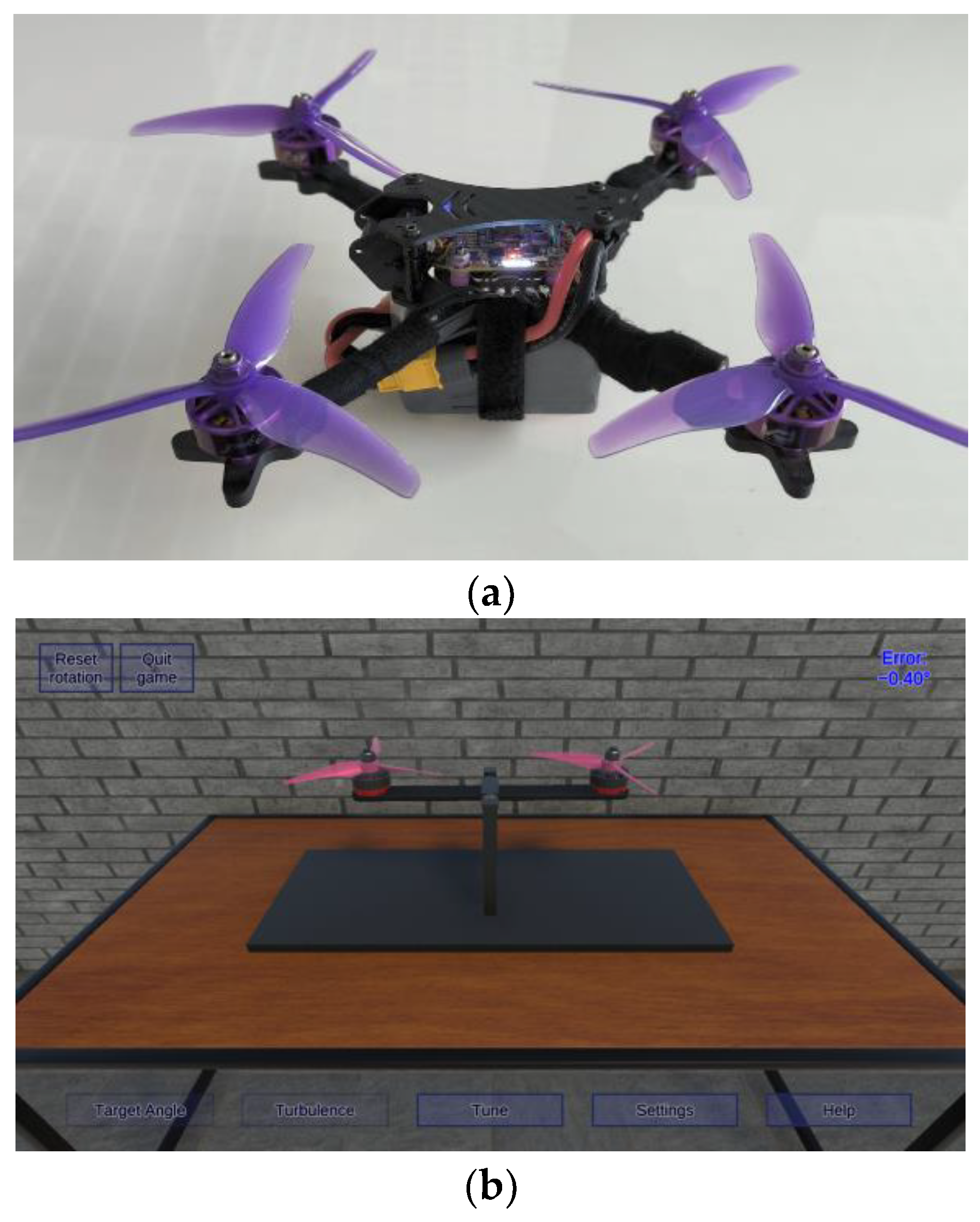
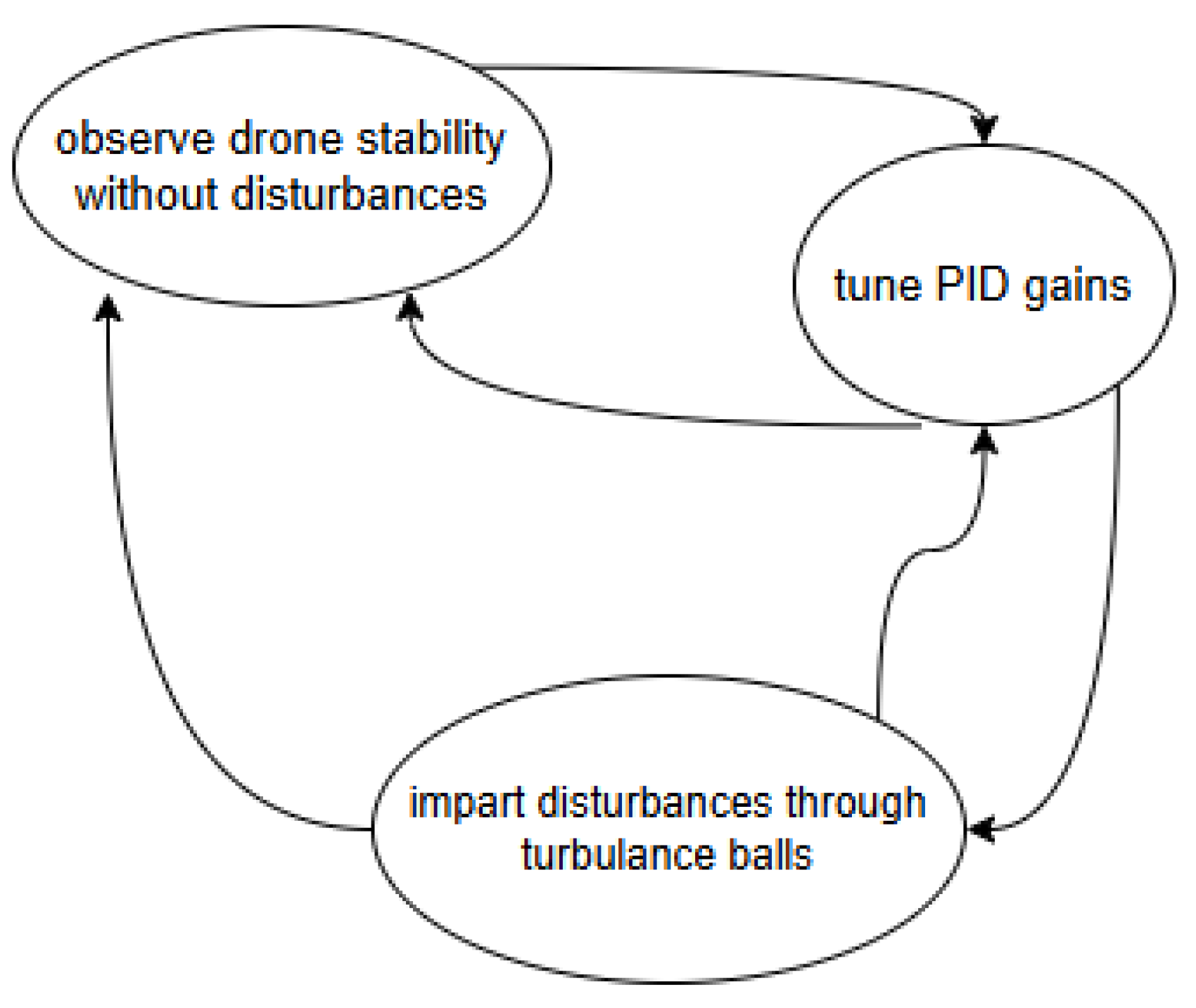
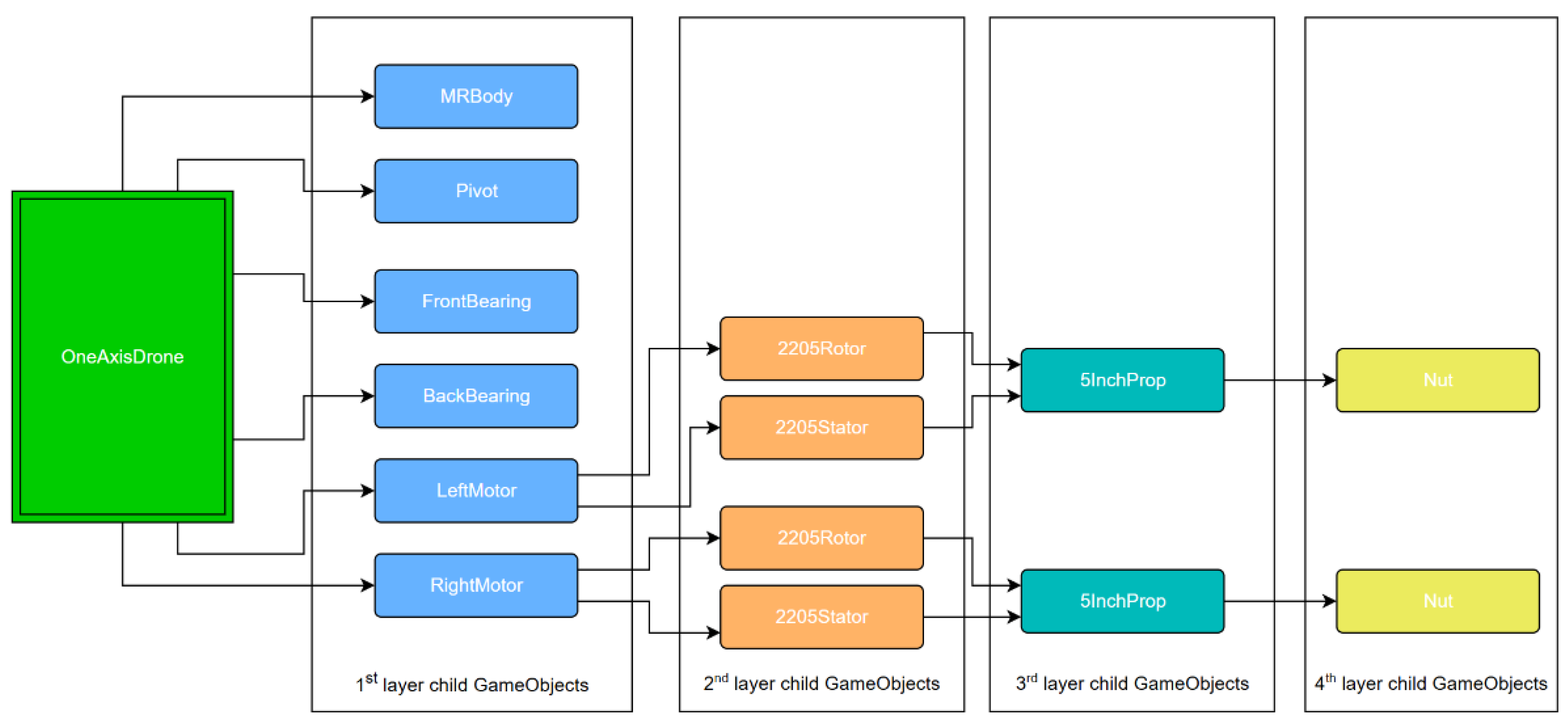
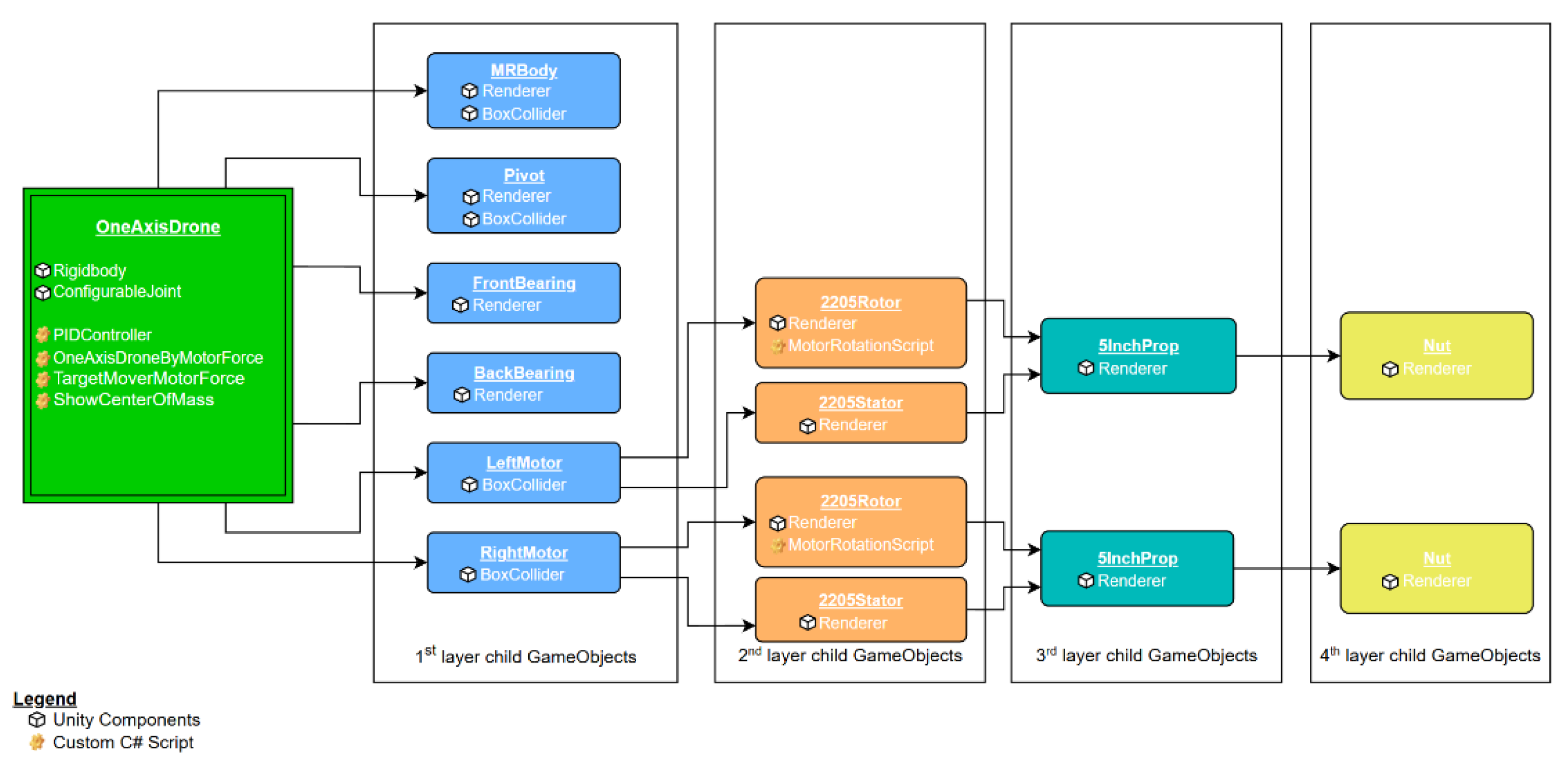
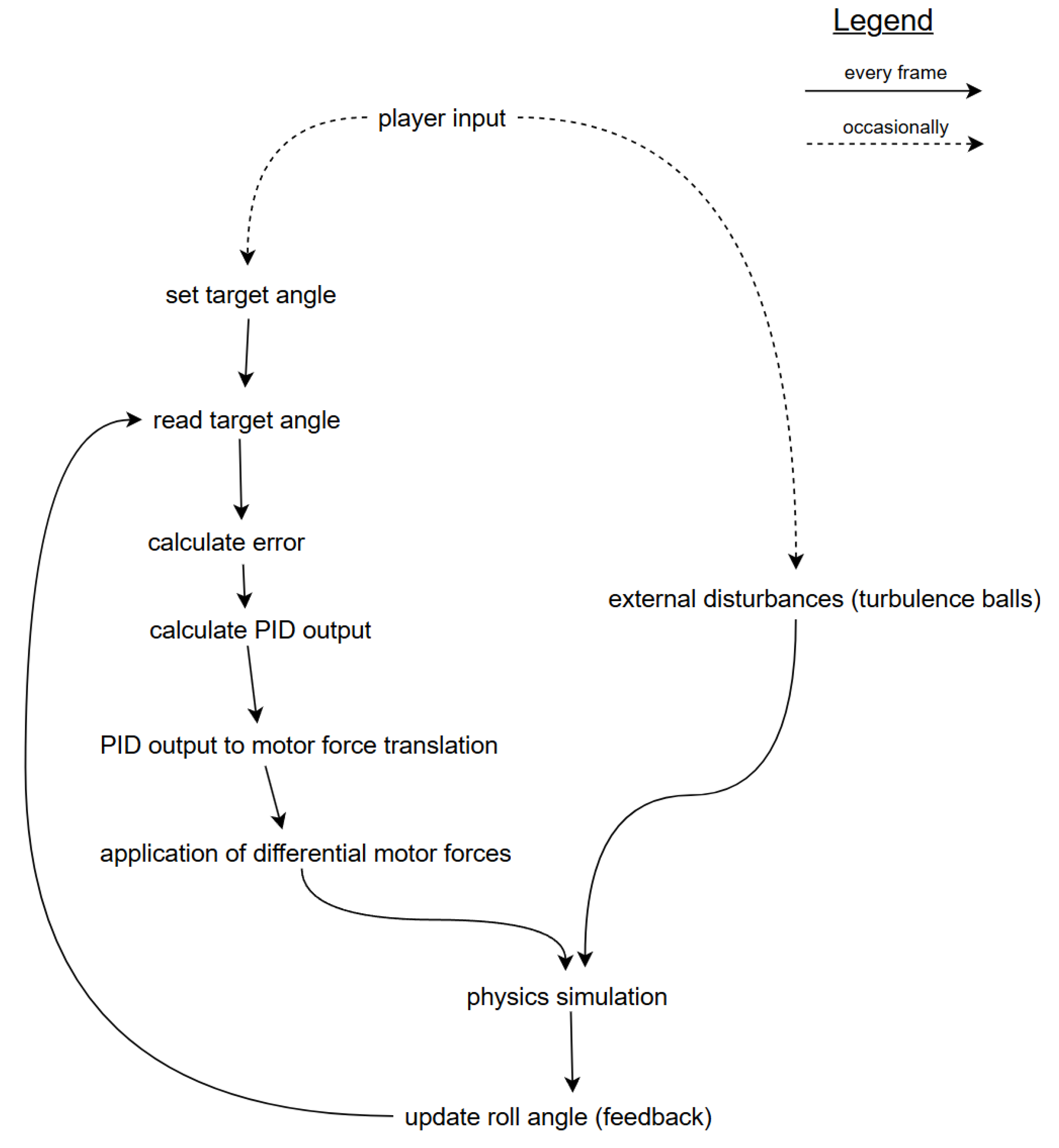
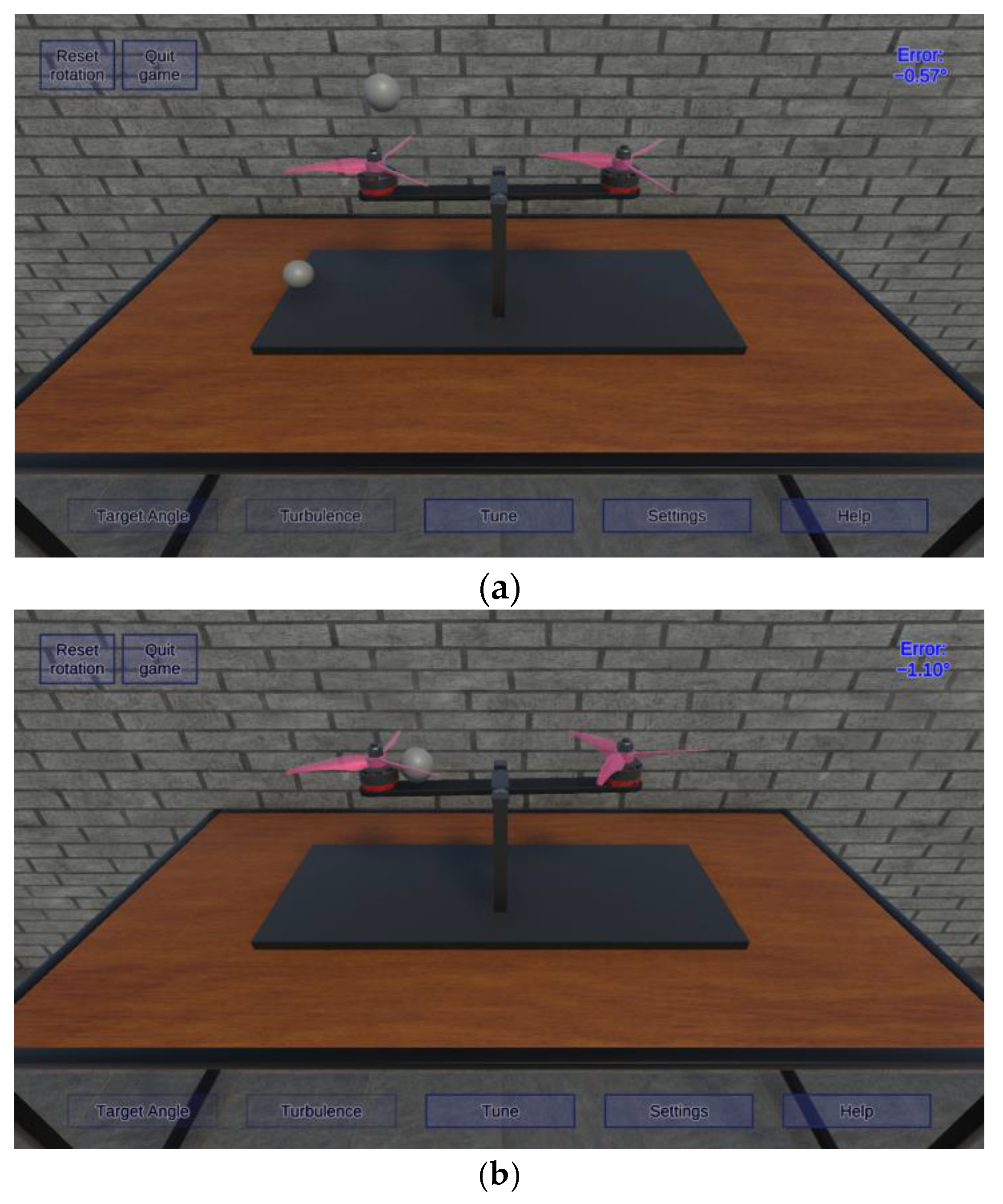
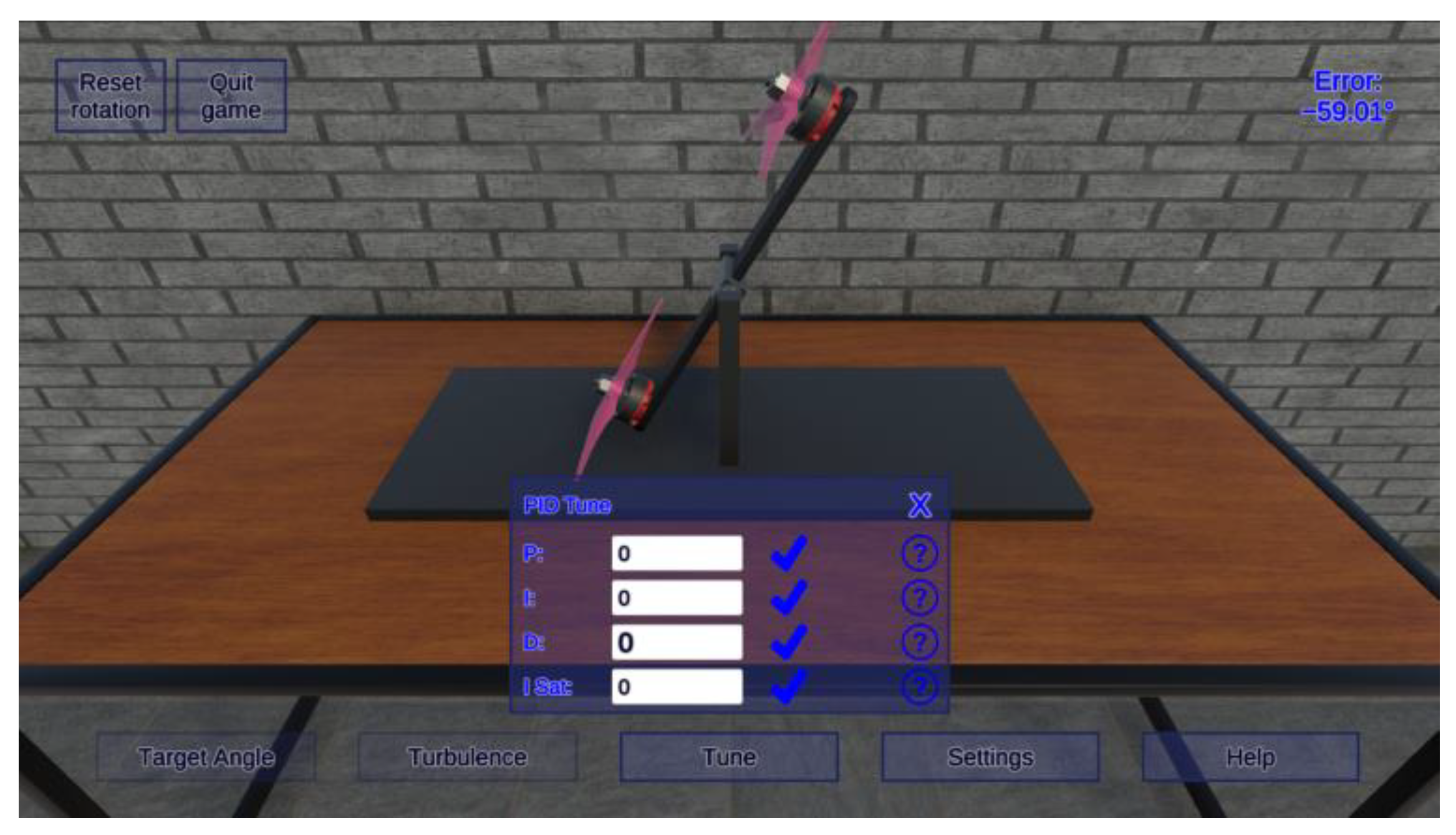
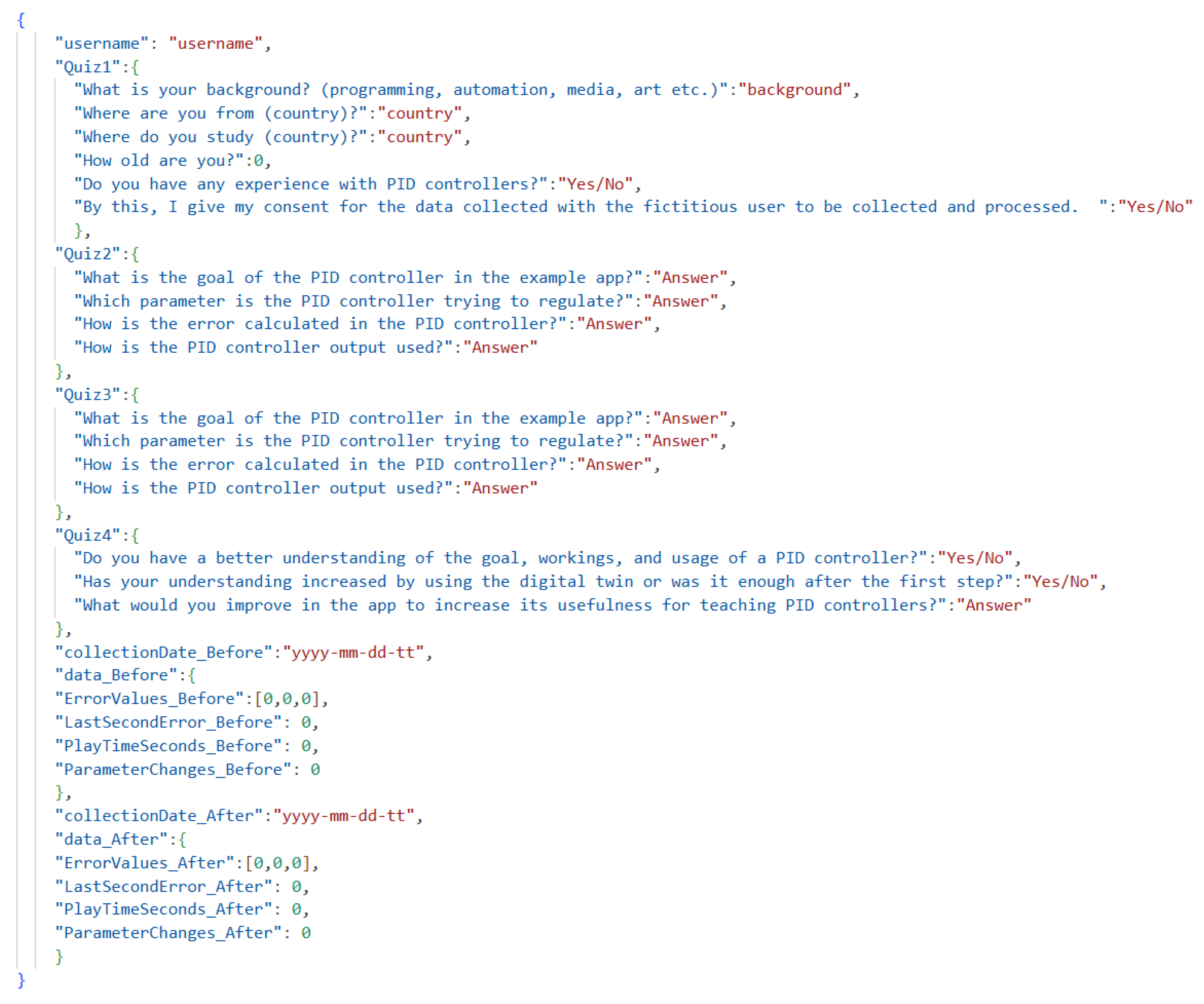
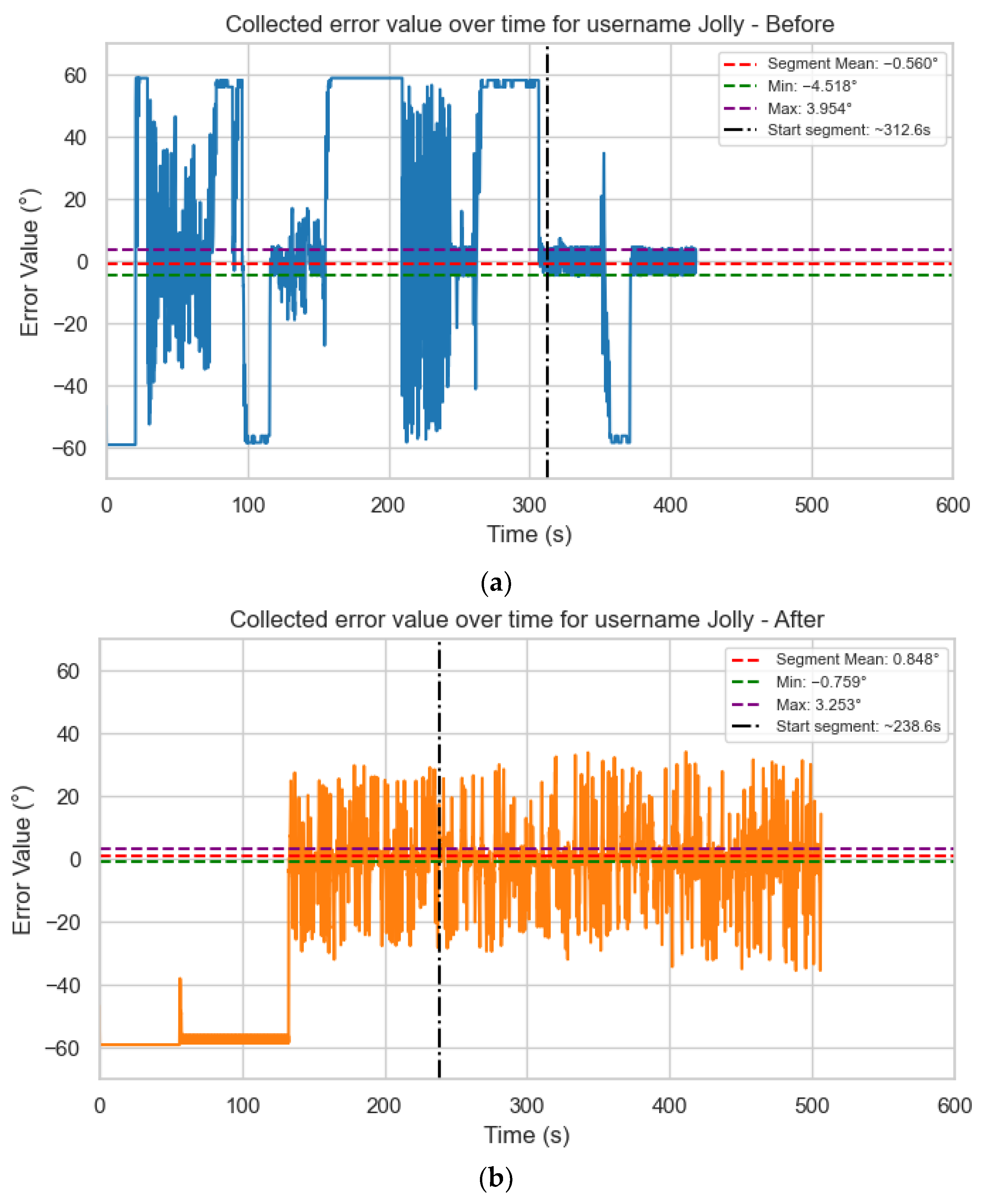
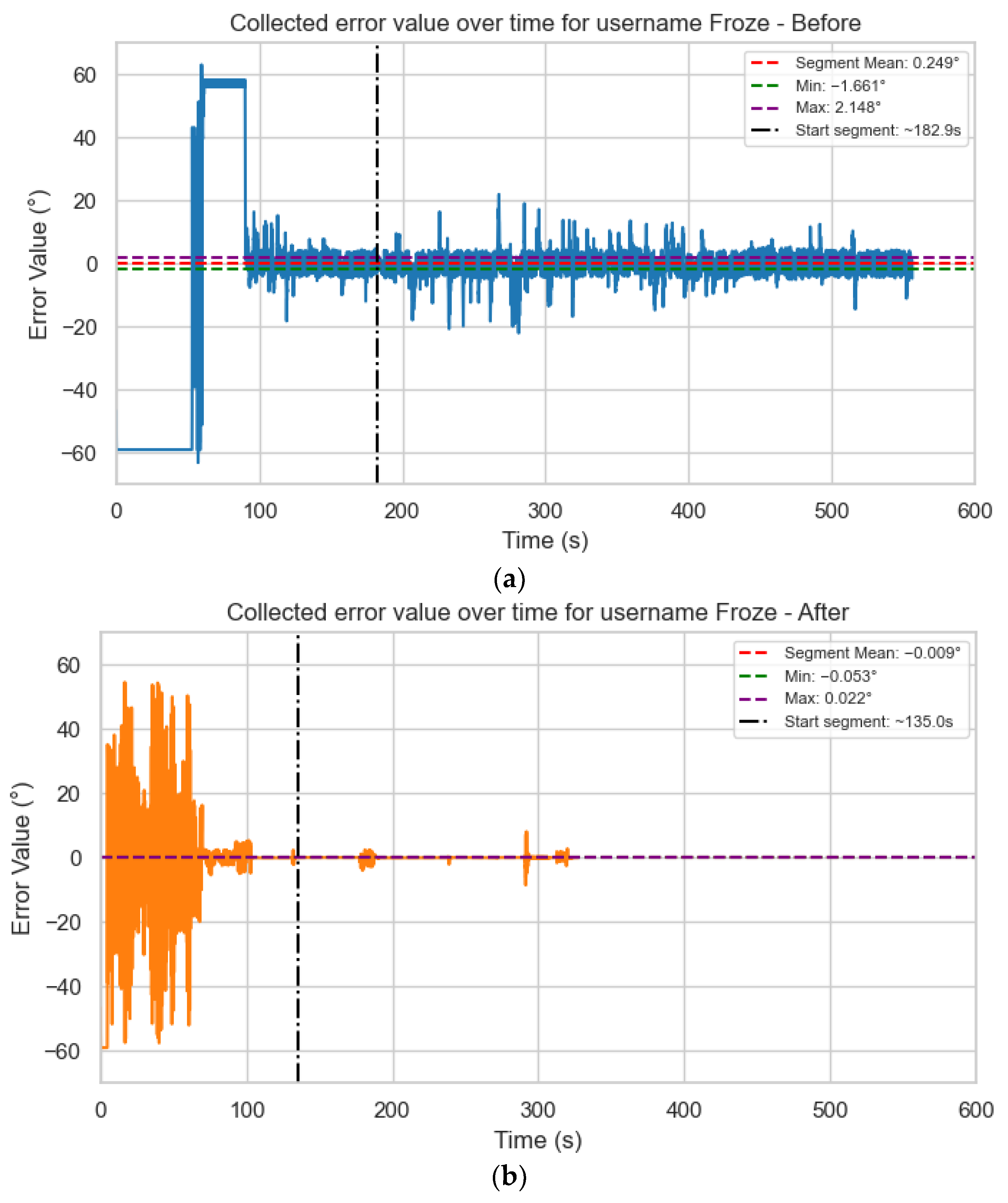
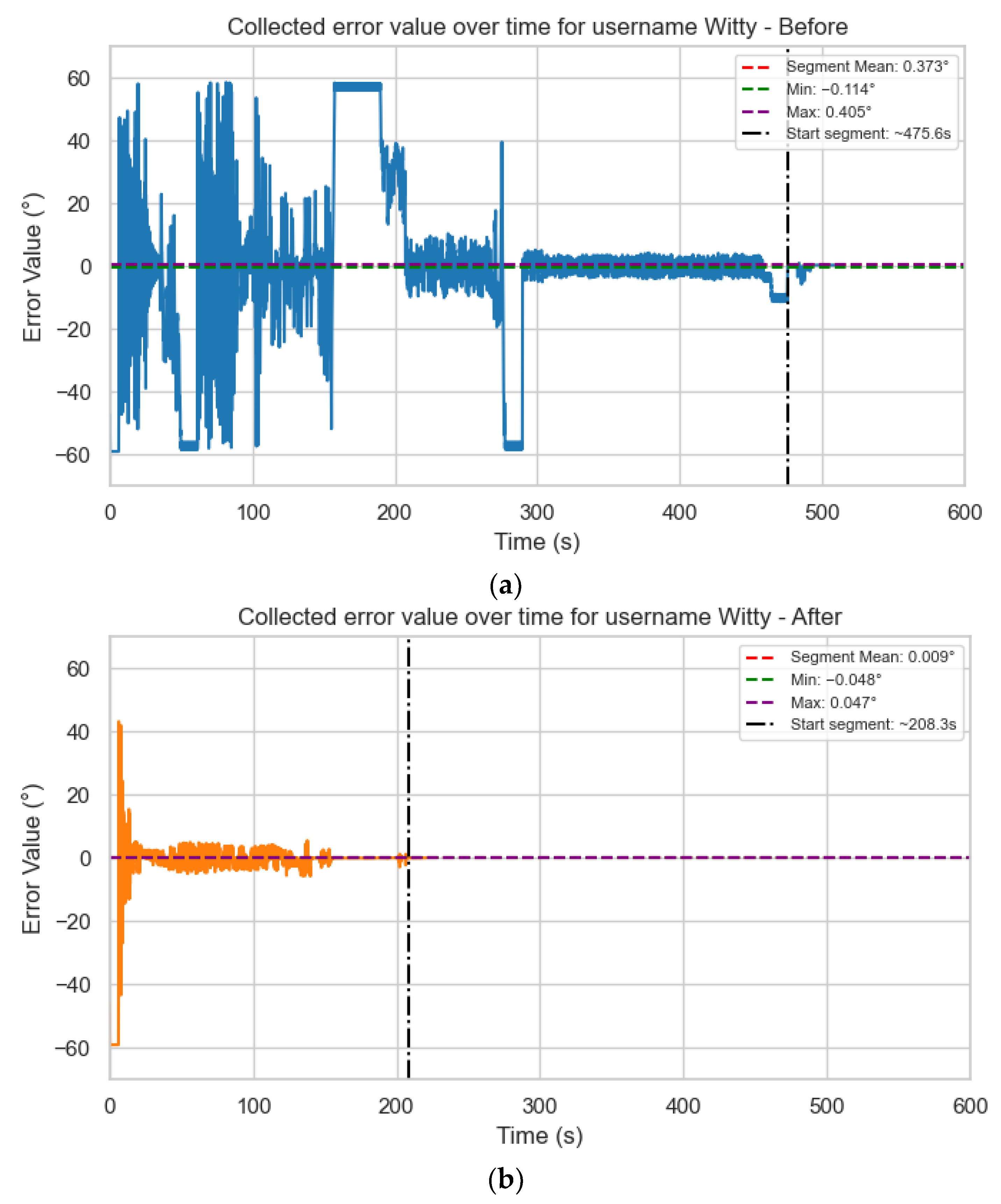
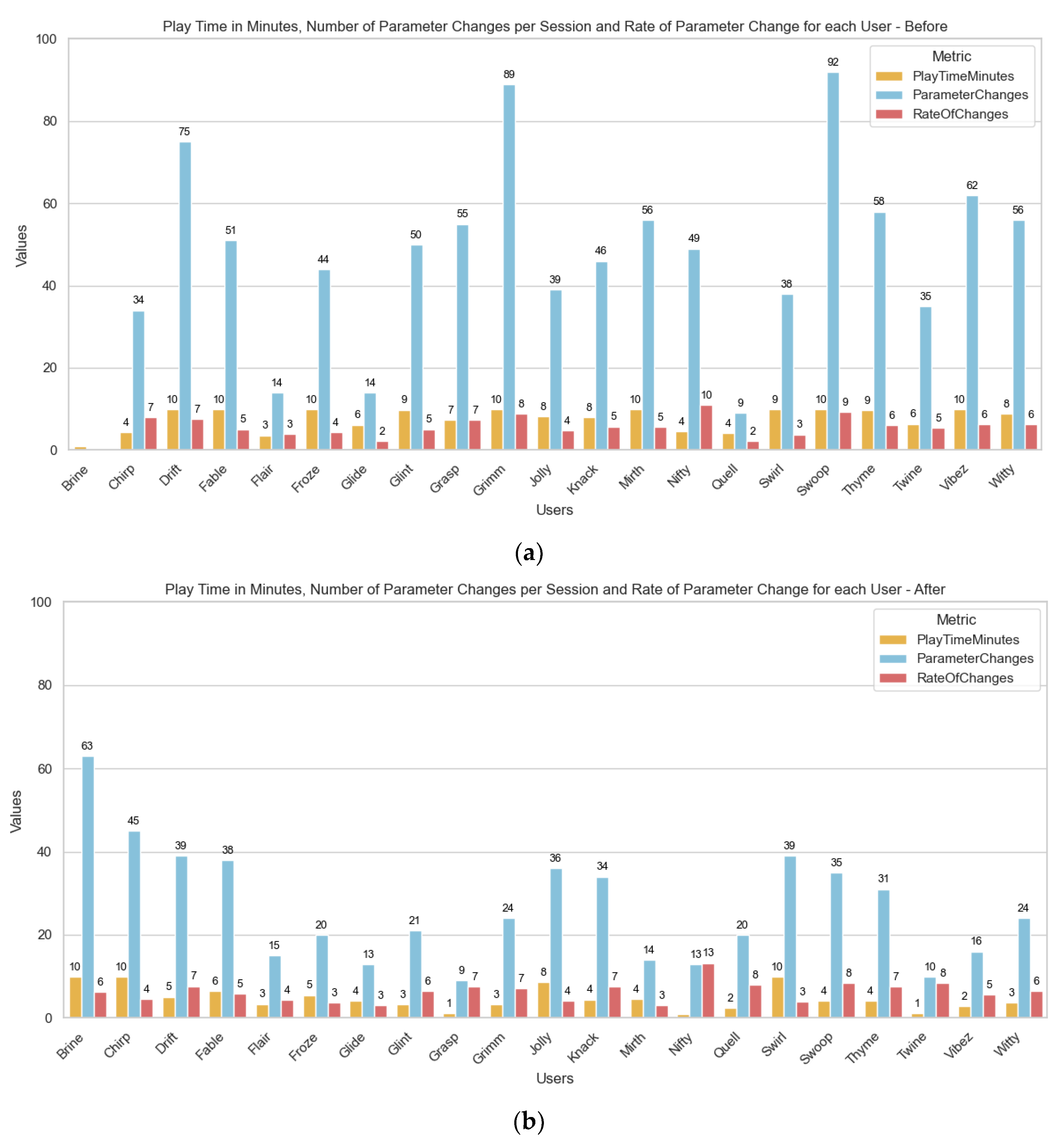
| Parameter | Description | Editable by |
|---|---|---|
| Proportional gain | Elicits a response that is proportional to the error | Player (UI) |
| Integral gain | Reacts to steady-state error | Player (UI) |
| Derivative gain | Dampens output based on error change | Player (UI) |
| Integral saturation | Clamps the integral term to prevent windup | Player (UI) |
| Target angle | Desired roll angle of the drone if oscillation is disabled | Player (UI) |
| Target movement speed | Rate at which the target value oscillates if automatic mode is enabled | Player (UI) |
| Turbulence ball mass | Controls disturbance strength during collisions | Player (UI) |
| Controller output limits | Clamps the PID-controller output | Developer |
| Motor KV rating | For determining the max RPM of the motor (visual only) | Developer |
| Battery cell count | For determining the max RPM of the motor (visual only) | Developer |
| Maximum motor thrust | Defines maximum force a single motor can produce | Developer |
| Minimum thrust percentage | Ensures propellers never stop fully, maintaining stability and visual realism | Developer |
| Description | Panels |
|---|---|
| Allows players to set a static target value or generate automatic oscillations | Target angle panel |
| Allows players to set the mass of the turbulence balls | Turbulence panel |
| Allows players to modify KP, KI, KD, and ISat (integral saturation) | Tune panel |
| Will contain settings in future releases. | Settings panel |
| Provides short instructions describing the main actions undertaken by the player | Help panel |
| Total Score Quiz 2 | Total Score Quiz 3 | Difference | Absolute Difference | Difference Sign | Rank | T− | T+ | W |
|---|---|---|---|---|---|---|---|---|
| 0.75 | 0.75 | 0 | 0 | 0 | - | |||
| 1 | 1 | 0 | 0 | 0 | - | |||
| 0.75 | 0.75 | 0 | 0 | 0 | - | |||
| 0.75 | 0.75 | 0 | 0 | 0 | - | |||
| 0.75 | 0.75 | 0 | 0 | 0 | - | |||
| 0.75 | 0.5 | −0.25 | 0.25 | −1 | 6.5 | |||
| 0.75 | 1 | 0.25 | 0.25 | 1 | 6.5 | |||
| 0.75 | 0.5 | −0.25 | 0.25 | −1 | 6.5 | |||
| 0.75 | 1 | 0.25 | 0.25 | 1 | 6.5 | |||
| 0.25 | 0.5 | 0.25 | 0.25 | 1 | 6.5 | 82.5 | 53.5 | 53.5 |
| 0.75 | 0.5 | −0.25 | 0.25 | −1 | 6.5 | |||
| 0.75 | 1 | 0.25 | 0.25 | 1 | 6.5 | |||
| 1 | 0.75 | −0.25 | 0.25 | −1 | 6.5 | |||
| 0.25 | 0.5 | 0.25 | 0.25 | 1 | 6.5 | |||
| 0.5 | 0.25 | −0.25 | 0.25 | −1 | 6.5 | |||
| 0.25 | 0 | −0.25 | 0.25 | −1 | 6.5 | |||
| 0.25 | 0.5 | 0.25 | 0.25 | 1 | 6.5 | |||
| 0.75 | 0.25 | −0.5 | 0.5 | −1 | 14.5 | |||
| 0.75 | 0.25 | −0.5 | 0.5 | −1 | 14.5 | |||
| 1 | 0.5 | −0.5 | 0.5 | −1 | 14.5 | |||
| 0.5 | 1 | 0.5 | 0.5 | 1 | 14.5 |
| Day1_nAUE | Day2_nAUE | Difference | Absolute Difference | Difference Sign | Rank | T− | T+ | W |
|---|---|---|---|---|---|---|---|---|
| 243.30624 | 228.72069 | −14.585555 | 14.585555 | −1 | 1 | |||
| 864.69223 | 901.28067 | 36.588443 | 36.588443 | 1 | 2 | |||
| 894.53042 | 938.78995 | 44.25953 | 44.25953 | 1 | 3 | |||
| 201.01026 | 326.56464 | 125.55438 | 125.55438 | 1 | 4 | |||
| 979.56527 | 848.03606 | −131.529215 | 131.52922 | −1 | 5 | |||
| 582.98658 | 776.97678 | 193.9902 | 193.9902 | 1 | 6 | |||
| 676.55098 | 923.2512 | 246.70023 | 246.70023 | 1 | 7 | |||
| 1063.6568 | 783.04613 | −280.610644 | 280.61064 | −1 | 8 | |||
| 1025.5287 | 741.60723 | −283.921514 | 283.92151 | −1 | 9 | |||
| 1189.2225 | 1514.816 | 325.59347 | 325.59347 | 1 | 10 | 142 | 89 | 89 |
| 1159.6068 | 776.09 | −383.51679 | 383.51679 | −1 | 11 | |||
| 695.76433 | 289.4231 | −406.341222 | 406.34122 | −1 | 12 | |||
| 962.47359 | 512.89044 | −449.583156 | 449.58316 | −1 | 13 | |||
| 970.08941 | 497.38339 | −472.706021 | 472.70602 | −1 | 14 | |||
| 1768.0974 | 1272.3261 | −495.77132 | 495.77132 | −1 | 15 | |||
| 833.1392 | 196.43131 | −636.707888 | 636.70789 | −1 | 16 | |||
| 1448.2651 | 666.45058 | −781.81449 | 781.81449 | −1 | 17 | |||
| 694.37792 | 1500.5228 | 806.14484 | 806.14484 | 1 | 18 | |||
| 796.06865 | 1620.2031 | 824.13441 | 824.13441 | 1 | 19 | |||
| 1611.9923 | 2501.8061 | 889.81381 | 889.81381 | 1 | 20 | |||
| 3491.1501 | 137.16073 | −3353.989352 | 3353.9894 | −1 | 21 |
Disclaimer/Publisher’s Note: The statements, opinions and data contained in all publications are solely those of the individual author(s) and contributor(s) and not of MDPI and/or the editor(s). MDPI and/or the editor(s) disclaim responsibility for any injury to people or property resulting from any ideas, methods, instructions or products referred to in the content. |
© 2025 by the authors. Licensee MDPI, Basel, Switzerland. This article is an open access article distributed under the terms and conditions of the Creative Commons Attribution (CC BY) license (https://creativecommons.org/licenses/by/4.0/).
Share and Cite
Brumar, R.; Nicola, S.; Ciocârlie, H. A Digital Model-Based Serious Game for PID-Controller Education: One-Axis Drone Model, Analytics, and Student Study. Multimodal Technol. Interact. 2025, 9, 111. https://doi.org/10.3390/mti9110111
Brumar R, Nicola S, Ciocârlie H. A Digital Model-Based Serious Game for PID-Controller Education: One-Axis Drone Model, Analytics, and Student Study. Multimodal Technologies and Interaction. 2025; 9(11):111. https://doi.org/10.3390/mti9110111
Chicago/Turabian StyleBrumar, Raul, Stelian Nicola, and Horia Ciocârlie. 2025. "A Digital Model-Based Serious Game for PID-Controller Education: One-Axis Drone Model, Analytics, and Student Study" Multimodal Technologies and Interaction 9, no. 11: 111. https://doi.org/10.3390/mti9110111
APA StyleBrumar, R., Nicola, S., & Ciocârlie, H. (2025). A Digital Model-Based Serious Game for PID-Controller Education: One-Axis Drone Model, Analytics, and Student Study. Multimodal Technologies and Interaction, 9(11), 111. https://doi.org/10.3390/mti9110111








